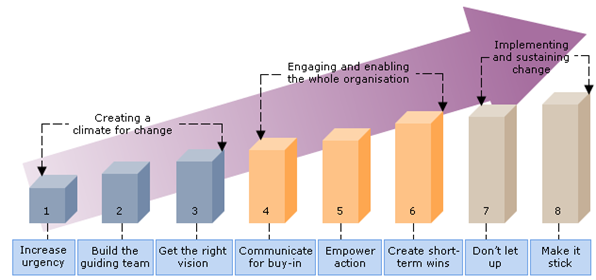
Why use Kotter's 8 Step Change Process in leading change
Professor Emeritus John Kotter of Harvard Business School is a renowned expert in leadership and change. His 8 Stpe Change Process is internationally recognised and very popular with many organisations the world over.
A handy guide to Kotter's 8 Step Change Process
Increase urgency
Why...
People need to acknowledge change is needed.
In practice...
Build a case for change describing why the change is needed.
Build the guiding team
Why...
What needs to be changed must be defined.
In practice...
Gather together the right people (no matter who they are or their grade) to help create the new vision.
Get the right vision
Why...
A clear vision helps to focus direction.
In practice...
Create a new vision which answers the case for change and which stands up to challenge.
Communicate for buy-in
Why...
Momentum for change must be created.
In practice...
Engage with key audiences to excite and motivate them about the change and to get them involved – enlist an army of champions.
Empower action
Why...
The right skills, tools and systems must be in place to empower people to change.
In practice...
Understand what roadblocks need to be addressed to remove cynicism and tackle any feeling of disempowerment.
Create short term wins
Why...
Keep and drive further momentum by showing people early benefits.
In practice...
Provide evidence of what could be possible by implementing and celebrating some early wins which can be done easily and quickly.
Don't let up
Why...
Change can be challenging and perseverance is key.
In practice...
Address any challenges, learn from mistakes, celebrate successes, and continue to implement change and reward people who are driving and championing change.
Make it stick
Why...
Change needs to be embedded to be fully realised in the long term.
In practice...
Use the tangible results of change to create an institutional culture which welcomes and rewards change.
Further reading
There are a number of useful case studies which explain why and how Kotter helped them achieve success from Ericsson to a global manufacturing company undergoing change.
